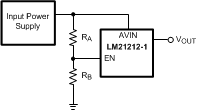SNVS671F February 2011 – May 2019 LM21212-1
PRODUCTION DATA.
- 1 Features
- 2 Applications
- 3 Description
- 4 Revision History
- 5 Description
- 6 Pin Configuration and Functions
- 7 Specifications
- 8 Detailed Description
- 9 Application and Implementation
- 10Layout
- 11Device and Documentation Support
- 12Mechanical, Packaging, And Orderable Information
Package Options
Mechanical Data (Package|Pins)
- PWP|20
Thermal pad, mechanical data (Package|Pins)
- PWP|20
Orderable Information
9.2.1.3 Precision Enable
The enable (EN) pin of the LM21212-1 allows the output to be toggled on and off. This pin is a precision analog input. When the voltage exceeds 1.35 V, the controller will try to regulate the output voltage as long as the input voltage has exceeded the UVLO voltage of 2.7 V. There is an internal current source connected to EN so if enable is not used, the device will turn on automatically. If EN is not toggled directly the device can be preprogrammed to turn on at a certain input voltage higher than the UVLO voltage. This can be done with an external resistor divider from AVIN to EN and EN to AGND as shown below in Figure 28.
 Figure 28. Enable Startup Through Vin
Figure 28. Enable Startup Through Vin The resistor values of RA and RB can be relatively sized to allow EN to reach the enable threshold voltage depending on the input supply voltage. With the enable current source accounted for, the equation solving for RA is shown below:

In the above equation, RA is the resistor from VIN to enable, RB is the resistor from enable to ground, IEN is the internal enable pull-up current (2 µA) and 1.35 V is the fixed precision enable threshold voltage. Typical values for RB range from 10kΩ to 100kΩ.